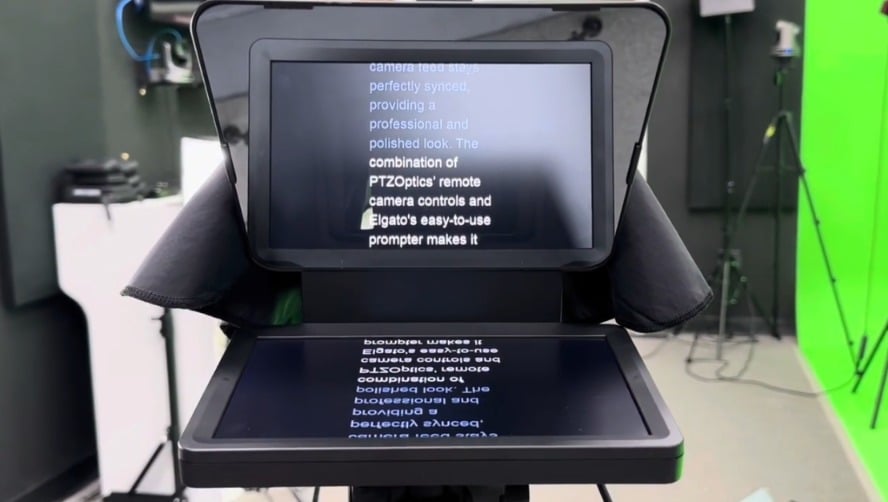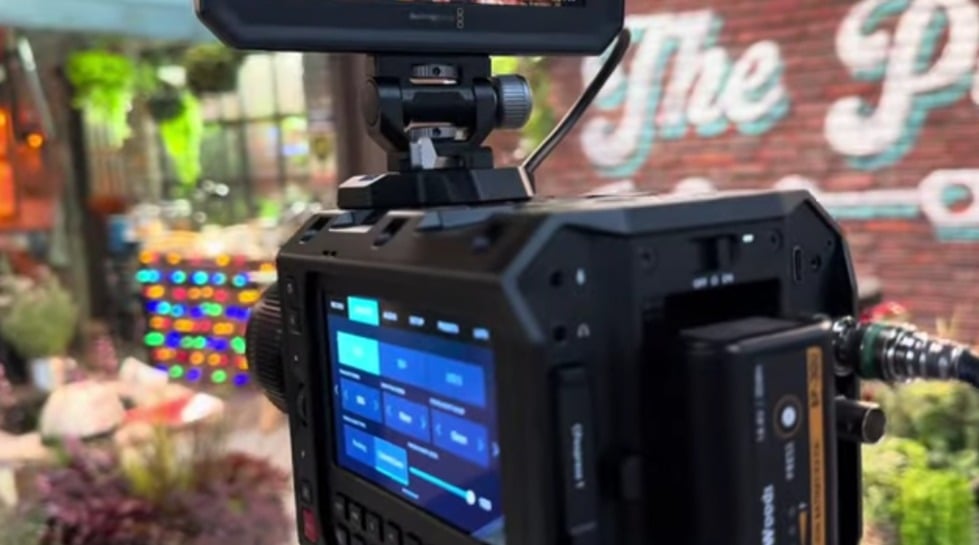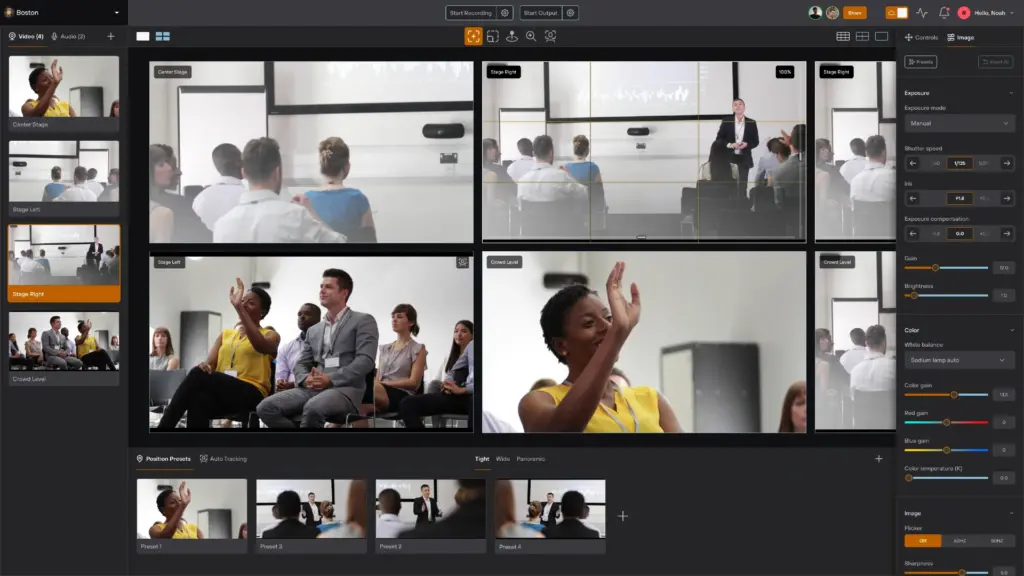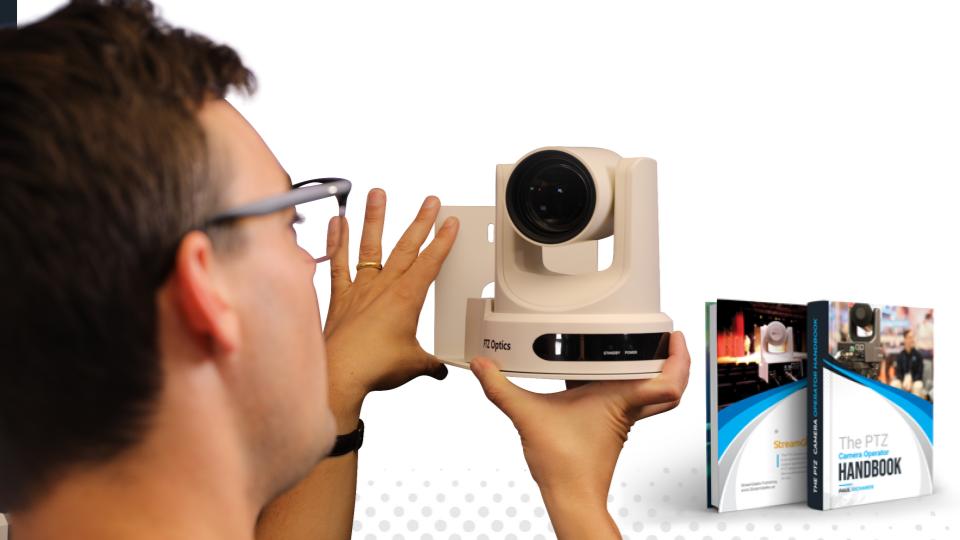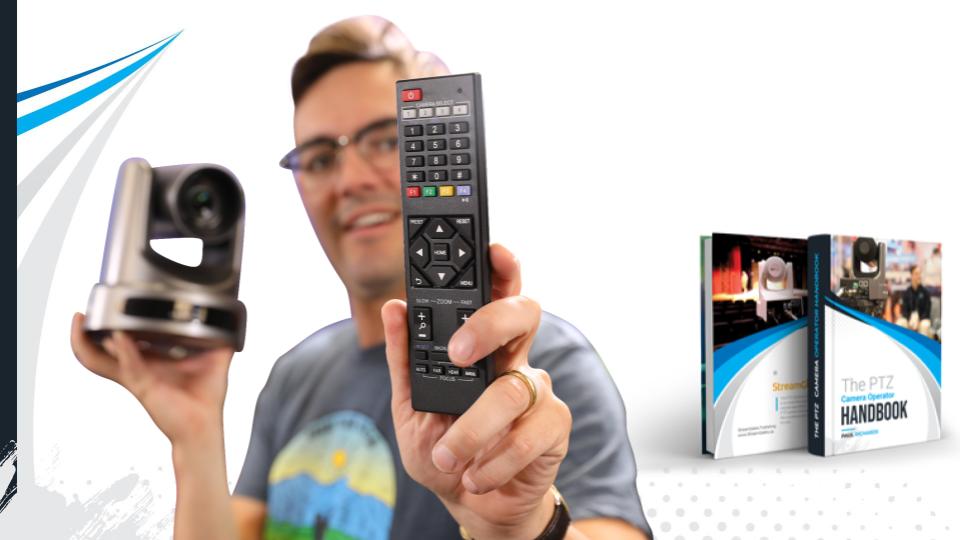PTZ Camera Control Options
Written by Paul Richards on November 15, 2021
PTZ cameras can be controlled in so many different ways, choosing your preferred option is somewhat of a personal preference. The only limitation you will come up against is the connection types that are available on your PTZ camera. Many professional PTZ camera operators will tell you that they prefer a dedicated joystick controller. Other more casual PTZ camera operators enjoy the wireless flexibility provided by smartphone apps. Perhaps the most popular solution is of course using the free PC and Mac software that is available online. In this chapter, you will learn about all the different ways you can control your PTZ camera.
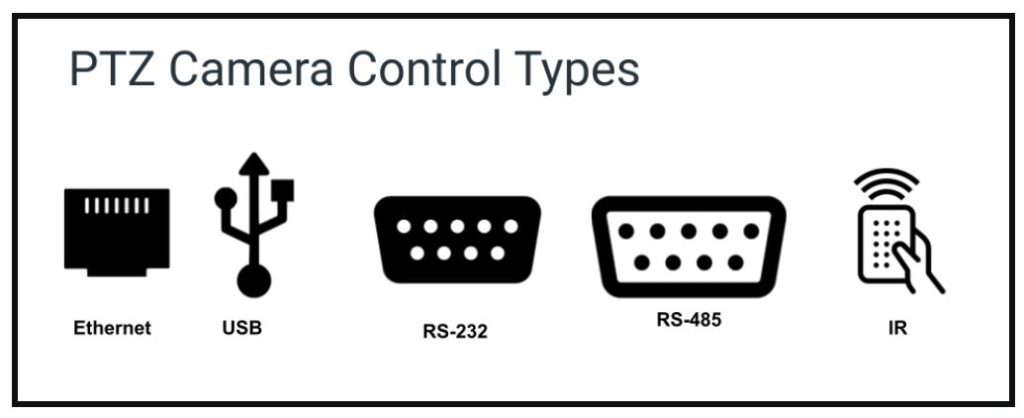
PTZ Camera Control Connections
PTZ camera control connection types:
| Type | Pros | Cons |
| Ethernet |
|
|
| USB |
|
|
| RS-232 |
|
|
| RS-485 |
|
|
| Infrared |
|
|
Types of PTZ Camera Controls
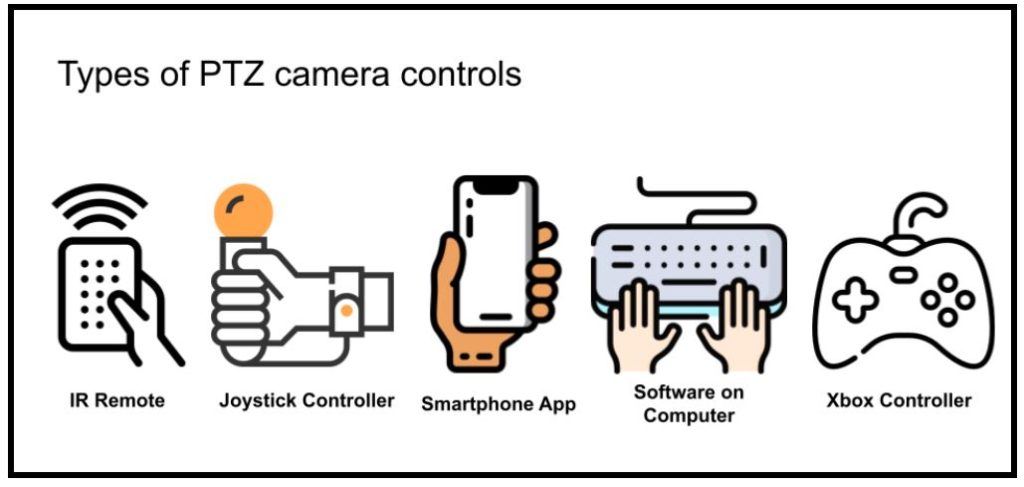
Types of PTZ Camera Controls
List of Controllers:
| Type | Pros | Cons |
| Joystick Controller |
|
|
| Smartphone App (iOS, Android, Kindle) |
|
|
| IR Remote Control |
|
|
| PTZOptics Mac & PC Apps |
|
|
| Software Integration (OBS, Wirecast, vMix, ect) |
|
|
| Open Source Control Software |
|
|
| Xbox Controller |
|
|
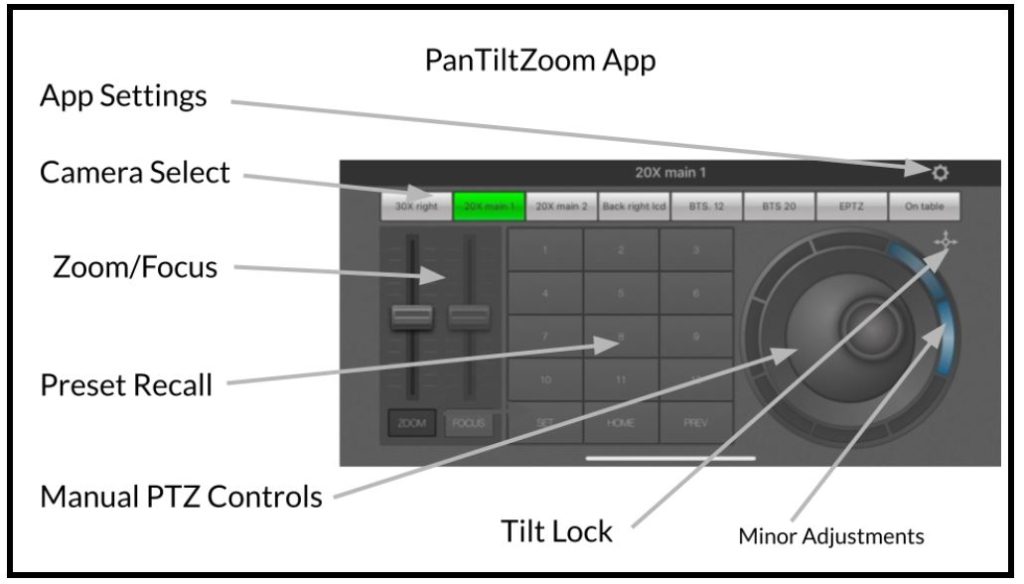
PanTiltZoom App
Smartphone apps
If you are just getting started with PTZ camera controls, the PanTiltZoom app is a great place to start. The user interface is very intuitive and user-friendly. Setting up a PTZ camera to work with this app is very simple. You simply need to go into the settings menu and enter your camera’s IP address. If you do not yet know your camera’s IP address, you will learn how to set one up in an upcoming chapter.
The app can control up to eight cameras. As you can see, there are eight buttons at the top of the interface which allows you to choose the camera you would like to control. The camera you are currently controlling will illuminate. On the right-hand side of the app, you can easily take control of your PTZ camera, and you will notice that the controls are instantaneous even over a WiFi connection. On the left-hand side, you have easy access to your camera’s zoom and focus capabilities. Tapping the zoom and focus buttons will disable/enable your ability to adjust the focus or zoom. This is ideal if you do not want to accidentally adjust one of these settings.
One of the most popular features is of course, setting up camera presets. To do this you will want to have a monitor or window open to preview the video from your camera. Once you have a visual on the camera’s video, you can move the camera to a specific location and press the “SET” button. This will allow you to save the preset location into one of the 12 preset buttons available. Another handy feature is the ability to lock the tilt for your camera. This is ideal if you are following a subject left and right but have no need to tilt the camera up and down. Finally, a slightly hidden feature in the user interface is the little buttons around the edges of the manual PTZ joystick. These are used to make minor adjustments, and they will move the camera the least amount possible. These are ideal for moving the camera ever so slightly to get the perfect composition.
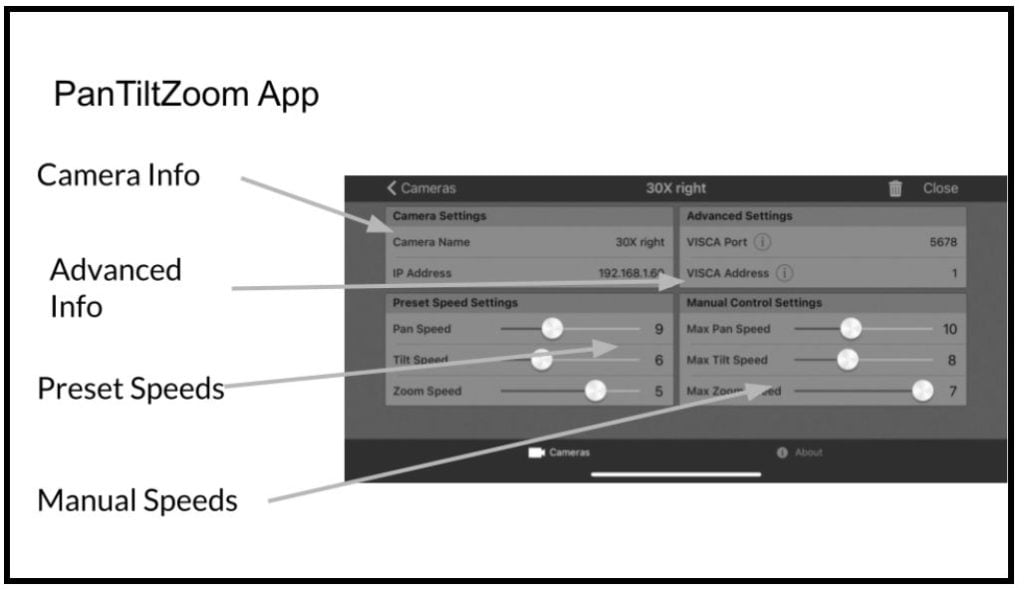
Smartphone app settings for PTZ
The settings area is very simple to navigate. All you need to do is select the camera button and click the settings cog to open it up. You have the ability to enter your camera’s information, including a name that will show up in the app. You also have the ability to adjust PTZ preset speeds and manual PTZ speeds. These speeds are ideal for camera operations of many different types. So, you will have to play around with these speed settings in order to find the correct settings you need.
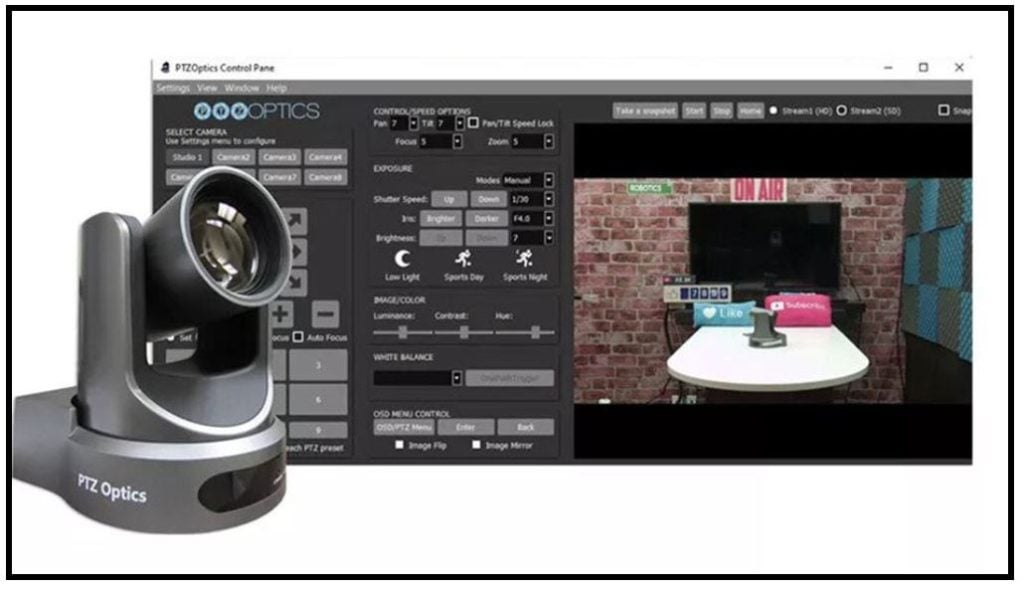
PTZ Camera App for Windows and Mac
PTZ Control Software
The free PTZOptics camera control app for both Mac and PC computers has become a popular choice for PTZ camera operators because it provides a long list of features designed for PTZ camera operation. The application features a compact mode for simple camera controls, but under the hood, this application can do quite a lot.
Just check out this long feature list:
- Control up to 8 PTZOptics cameras over an IP connection (LAN) or USB
- Live Video Preview Mode with automatic camera switching
- Set up to 9 camera presets with image snapshot storage o Save up to 6 presets with image snapshots
- Name each unique preset & capture image representations
- Pan, Tilt and Zoom Speeds & Pan & Tilt Speed Locks
- Iris Controls
- Focus Controls (With Focus Speed)
- Selectable exposure modes (Auto, Manual, SAE, AAE, and Brightness)
- Advanced image controls for Contrast, Luminance, Hue, and Exposure
- Select between exposure modes
- Flip and Mirror camera image
- On-Screen Display Controls
- Real-time reporting of camera options status
- Xbox Joystick Controller Support (Windows Only)
- Compact, Advanced and Preview Modes
- Full-Screen Camera Preview Modes (SD & HD Options for bandwidth conservation) (Windows Only)
- Ability to snap and unsnap preview mode to the main application
- Ability to take a camera snapshot from preview mode
- Ability to choose if you want to store exposure information with each PTZ preset
- Option to control speeds between PTZ presets
- App now retrieves Serial Number and Camera Info
- Preset Hotkeys
- Set Pan and Tilt Limits
While this software may not work with every PTZ camera available today, it’s worth checking it out and seeing if it will work for you. The live video preview is ideal for camera operations from any computer on your network. The software also provides a very affordable way to get started with a PTZ joystick via the USB Xbox controller integration. USB-connected Xbox controllers are available on Amazon for roughly $25. So, this is a great way to get a PTZ controller setup for a volunteer or something helping out during your production.
Another great feature is the ability to save PTZ presets with an image in the button. As soon as you set a PTZ preset with this software, it will automatically store an image in the button you used. This way you can quickly see a picture of where your camera will move as soon as you click the button.
PTZOptics is not the only PTZ camera manufacturer with advanced PTZ control software. RocoSoft is actually one of the world’s best known software companies focused on PTZ camera operation. Most PTZ camera manufacturers offer their own software to control specific PTZ cameras, but Rocosoft actually designs non-proprietary software designed to work with a long list of camera manufacturers. It’s worth learning about your software control options as you learn more about how to control your PTZ camera.
Video Production Software Integrations
PTZ cameras have been integrated into a long list of popular video production software solutions because they provide users a single interface to control the look and feel of the live productions. Software like OBS, Wirecast, vMix, Livestream Studio, and more can be installed on a regular computer and provide users with all the tools they need to create a professional-looking video. Most video producers are used to working inside of a video production software that provides them with the ability to switch between video inputs, add graphics and select a destination for recording or live streaming the entire project. Adding the ability to control PTZ cameras makes the “one-person production” much more powerful and adds new levels of camera movement automation that will be covered in an upcoming chapter.
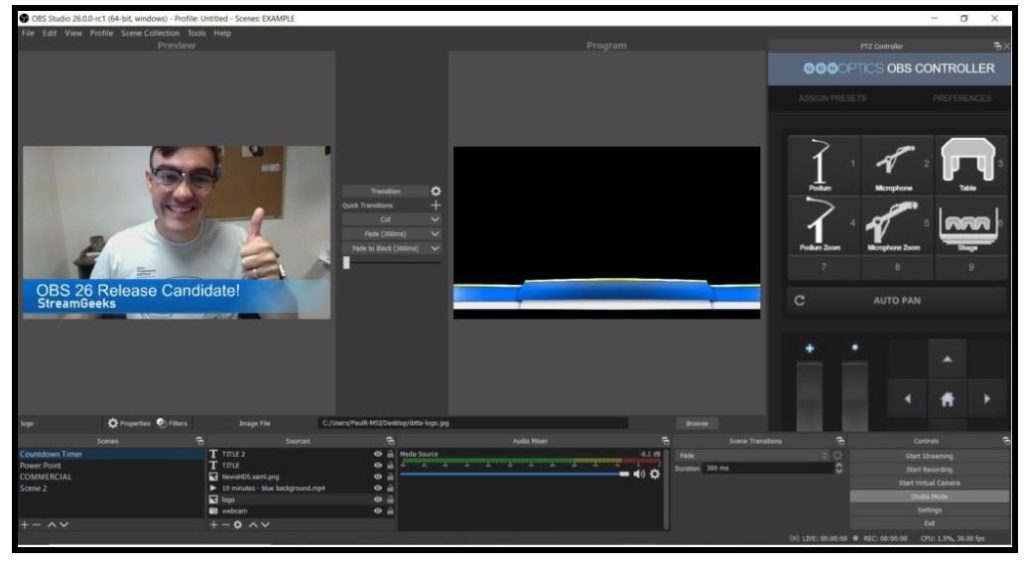
OBS Shown with PTZ camera controls
The picture above shows the popular OBS live streaming software with a custom PTZ camera control dock. Adding PTZ camera controls to a video production layout makes recalling PTZ presets much easier for producers who are already familiar with a given live streaming software solution. It is also possible to recall presets with OBS automatically when you switch between scenes. This automatic PTZ camera recall functionality will be covered in more detail in an upcoming chapter. It’s important to note that all video production software solutions will require the PTZ camera’s IP address in order to send commands to it.
PTZ Controls with a Joystick
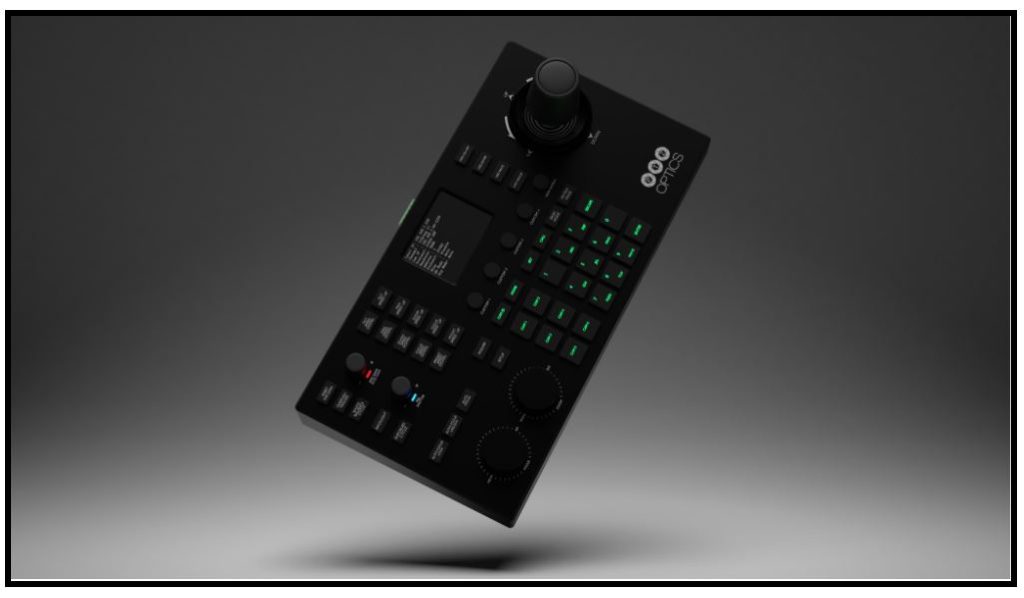
PTZOptics SuperJoy
A PTZ Joystick can add a whole new level of control and flexibility to any PTZ camera setup. Whether you’re using the latest PTZOptics SuperJoy G1 or another IP or serial joystick, here are a few tips that will help you get the most out of your controller and PTZ cameras.
The best way to familiarize yourself with the joystick is to connect your cameras, experiment with controlling pan, tilt, and zoom, set some presets, and adjust your PTZ camera settings. Once you’ve walked through all these steps, you should have a good handle on the essential operations and be able to continue to fine-tune the operation of your controller. This guide will provide best practices for camera operators and use a few popular PTZOptics joystick controllers as examples.
Connecting Your Cameras
You have the option of connecting cameras via serial/analog RS-232 or your local area network (LAN). Using the analog option will require connecting each camera individually or creating a daisy-chain where one camera is connected directly to the controller. Then, that camera is connected to the next one in line, creating a chain until all are connected. Serial connectivity is ideal for those without a network connection.
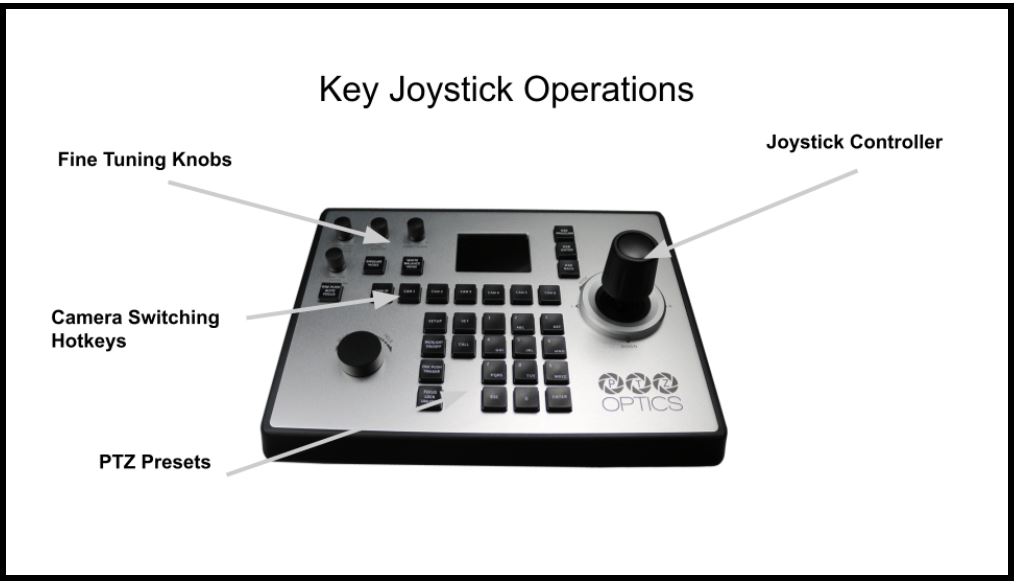
PTZ Joystick Key Functions
When using a LAN connection for IP cameras, the controller and all cameras must be connected to the network using ethernet cables. For many, connecting cameras via ethernet is ideal because a network connection can also provide the camera power with a PoE (Power Over Ethernet) network switch. Once the cameras are physically connected, you’ll need to add each one to the controller using the joystick controls. When using the LAN connection for IP control, you can also use the web interface.
PTZ Speed Settings
Your PTZ Joystick gives you fine motor control over your cameras. Fine-tune the speed at which your pan, tilt, and zoom control respond to joystick input. Use the individual up and down buttons for each movement (pan, tilt, and zoom). As you adjust, you can use the joystick to experience the speed of that setting and continue to adjust as necessary.
Setting Presets
Presets are one of the most powerful features of a PTZ Joystick. With just a couple of buttons, you can quickly move any camera to any pre-programmed pan, tilt, and zoom setting.
First, select the camera you wish to work with and move it, using the joystick, to the desired position and zoom level. For presets 0-9, just hold the number on the keypad for 3+ seconds until the controller display shows that it’s set. To recall presets 0-9, just select the camera and then press the desired preset number.
For presets 10 through 255, the process is slightly different:
- Move the camera to the desired location, press the “Set” button, followed by the preset number you wish to use, and then press “Enter.”
- To recall the settings, select the camera number, then press recall.
- Enter the number on the keypad and press enter.
Note: Use presets 0-9 for your most accessed presets since they can be recalled with just one button.
Checking Preset Movement Speed
While you may have already adjusted the movement speed for pan, tilt, and zoom, you’ll also need to check and adjust the speed for moving between presets. Use the preset speed up and down buttons to adjust the speed and then test it by recalling your presets to inspect the movement.
Tune Exposure Settings
Adjust the exposure settings for your PTZ cameras right from the joystick controller. Pressing the “Backlight” button controls the camera’s backlight compensation, toggling it on and off. The “Exposure Cycle” button allows you to cycle through the different exposure modes. Choose Auto, Manual, Shutter Priority, Iris Priority, & Brightness Priority. Then use the “Iris/Shutter” knob in all modes except auto to make manual adjustments.
Adjust Focus
Adjust the automatic focus feature from the joystick controller and manually fine-tune the focus on each camera. The “Auto Focus” button turns the autofocus on and off. When it’s on, the “Auto Focus Lock” and “Auto Focus Unlock” buttons can hold the focus at a particular point (locked) or allow it to continue to seek the best focus point (unlock.) With autofocus off, the focus dial controls manual focusing.
As a PTZ camera operator, your job is to operate the camera and choose between a variety of available shots. Good communication between the camera operator and the video producer is ideal for creating professional video content.
Key Takeaways:
- The IR remote control is an important tool for setting up a PTZ camera.
- The IR remote control can be used to open up an on-screen display menu for adjusting the camera’s settings.
- Most IR remote controls can control more than one PTZ camera using the camera switch buttons.
- Most IR remote controls feature shortcuts that help to quickly set up PTZ cameras on an IP network.
Learn more about PTZ Cameras
- See how PTZ cameras are transforming video production here
- Learn high level, what a PTZ camera really is here
- Learn about every essential part of a PTZ camera here
- Learn about who is using PTZ cameras here
- Learn about the different types of PTZ cameras here
- Learn how to use an IR remote control with your PTZ cameras here
- Learn about the various PTZ camera control options here
- Learn how to mount a PTZ camera here
- Learn how to set the exposure of your PTZ camera here
- Learn about PTZ camera operation best practices here
- Learn about all the latest PTZ camera features here
- Learn how to automate PTZ camera controls here
- Learn more about Networking PTZ cameras here
- Learn about the new ePTZ camera technology here
- Learn about how innovations in video production are changing the industry here
- Learn how to use PTZ cameras for remote production here
